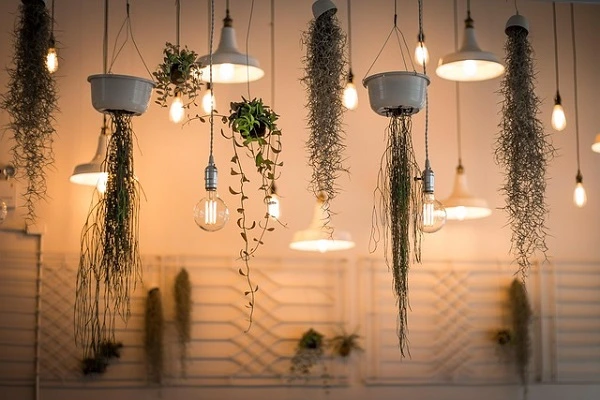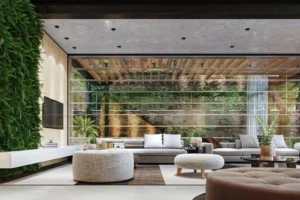How would you like growing fresh herbs, crisp greens, or even vibrant strawberries right inside your home, no matter the season? That’s the beauty of vertical hydroponic gardening—a space-efficient, soil-free method that allows you to cultivate plants in stacked layers. Whether you’re a hobbyist or an urban farmer, this innovative approach maximizes yield while minimizing the space needed.
One of the most crucial factors in a thriving hydroponic setup is lighting. Since plants rely on light for photosynthesis, providing the right illumination directly impacts their growth, nutrient absorption, and overall health. In an indoor environment where natural sunlight is limited or inconsistent, artificial lighting becomes essential.
This is where LED grow lights come into play. Designed to mimic the sun’s natural spectrum, these energy-efficient lights help plants flourish continuously, regardless of external weather conditions. Unlike traditional lighting options, LEDs offer superior efficiency, customizable light spectrums, and lower heat output—making them the perfect fit for vertical hydroponic systems. Choosing the right LED grow lights can make all the difference between a struggling garden and a lush, productive one. In this guide, we’ll explore what to look for and how to select the best option for your unique setup.
Understanding LED Grow Lights
If you’re growing plants indoors, you’ve probably heard about LED grow lights. But what exactly are they, and why are they such a game-changer for hydroponic gardening?
LED (Light Emitting Diode) grow lights are specially designed to provide the wavelengths of light that plants need for photosynthesis. Unlike standard household bulbs, which produce a broad and often inefficient spectrum, LED grow lights are tailored to deliver the ideal balance of red, blue, and full-spectrum lighting to support plant growth at every stage—from sprouting to fruiting.
So, why choose LED over traditional lighting options like fluorescent or high-pressure sodium (HPS) bulbs? For starters, LEDs are incredibly energy-efficient, meaning they consume less electricity while producing the same or even better results. This translates to lower utility bills without sacrificing plant health. Additionally, they generate minimal heat, reducing the risk of scorching your plants and making climate control easier in an indoor setup.
Another major advantage is their long lifespan. While other types of grow lights may burn out or lose efficiency after a few months, quality LED lights can last for many growing cycles, providing reliable illumination through every season. Plus, many models come with adjustable spectrum settings, allowing you to fine-tune the light output based on your plants’ specific needs.
Whether you’re growing leafy greens, herbs, or flowering plants, LED grow lights provide the right balance of efficiency, durability, and customization—making them an essential tool for anyone looking to cultivate healthy crops no matter the time of year.
Key Factors to Consider When Choosing LED Grow Lights
Not all LED grow lights are created equal, and picking the right one can make a huge difference in the success of your vertical hydroponic garden. From spectrum and intensity to efficiency and automation, here are the key features to keep in mind when selecting the best lighting for your indoor setup.
Light Spectrum: Full Spectrum vs. Specific Wavelengths
Plants rely on different wavelengths of light throughout their growth cycle. Some LED lights offer a full-spectrum output, mimicking natural sunlight and supporting all stages of plant development—from seedlings to fruiting. Others focus on specific wavelengths, such as red and blue light, which are crucial for photosynthesis. If you want a simple, all-in-one solution, full-spectrum LEDs are the way to go. However, if you prefer to fine-tune the lighting for different plants or stages of growth, choosing a light with adjustable spectrums can give you more control.
PPFD and Intensity: Reaching Every Layer of Your Garden
When growing in vertical layers, you need to ensure that each level of plants gets sufficient light. This is where PPFD (Photosynthetic Photon Flux Density) comes in—it measures how much usable light actually reaches the plants. The higher the PPFD, the better the light penetration, ensuring that even the lowest layers in your setup receive adequate illumination. Look for LED grow lights with high PPFD values and a design that distributes light evenly to avoid weak growth in shaded areas.
Energy Efficiency: Maximizing Output While Reducing Costs
LEDs are known for their low energy consumption, but not all models are equally efficient. Pay attention to the wattage and how much light output (measured in PPFD) you get per watt. A well-designed LED grow light will use minimal electricity while still delivering strong, consistent lighting. Choosing an energy-efficient model helps keep operational costs down, allowing you to grow fresh produce across every season without driving up your power bill.
Heat Output and Cooling: Keeping Your Plants Comfortable
Since vertical hydroponic gardens often have multiple stacked layers, heat buildup can become an issue, especially in confined indoor spaces. Traditional grow lights, like HPS bulbs, generate significant heat, which can stress plants and require extra cooling. LED grow lights, on the other hand, produce much less heat. However, it’s still important to check whether the model you choose has built-in cooling systems, such as heat sinks or fans, to prevent overheating and maintain a stable growing environment.
Adjustability and Automation: Making Growth Effortless
One of the biggest advantages of modern LED grow lights is the ability to customize their settings. Features like dimmability allow you to fine-tune light intensity based on your plants’ needs, while programmable timers and smart controls make it easier to automate your lighting schedule. Some advanced models even sync with mobile apps, giving you full control over your garden’s lighting from anywhere. These features can be especially helpful if you’re growing crops throughout every part of the calendar, as they help you mimic natural daylight cycles with minimal effort.
Best LED Grow Lights for Vertical Hydroponic Systems
With so many LED grow lights on the market, finding the perfect one for your vertical hydroponic setup can feel overwhelming. The right choice depends on your budget, space, and the specific needs of your plants. Whether you’re looking for a cost-effective option or a high-tech lighting system, here’s what to consider when making your decision.
Top LED Grow Lights for Every Budget
- Budget-Friendly Options ($50–$150): If you’re just starting out or need a simple solution for leafy greens and herbs, look for compact LED panels with full-spectrum coverage. These lights are energy-efficient, easy to install, and provide enough illumination for small-scale hydroponic setups.
- Mid-Range Choices ($150–$500): For more advanced growers, mid-tier LEDs offer better PPFD (light intensity), adjustable spectrums, and improved heat dissipation. These models work well for multi-layer gardens and can support plants through every phase of growth, from sprouting to flowering.
- High-End Performance ($500+): If you’re serious about maximizing yield and quality, premium LED grow lights come with cutting-edge features like smart automation, customizable light spectrums, and high-intensity output to ensure even lower layers in your vertical system receive adequate illumination. These options are ideal for those growing a variety of crops across multiple seasons.
Features to Look for in a Vertical Hydroponic Garden
- Slim, Space-Saving Design: Since vertical systems rely on stacked layers, choose LEDs that are compact and easy to mount without blocking airflow.
- High PPFD and Uniform Light Spread: The goal is to ensure all plants receive enough light, even those on lower shelves. Lights with a high PPFD rating and wide beam angles help prevent uneven growth.
- Dimmability and Spectrum Control: Adjustable settings let you fine-tune lighting based on plant needs, whether you’re germinating seeds, encouraging leafy growth, or promoting flowering.
- Energy Efficiency: Since lights will be running frequently, selecting an energy-efficient model helps reduce electricity costs while providing consistent illumination for your crops.
- Heat Management: Built-in cooling systems prevent overheating, which is especially important in stacked hydroponic setups where airflow may be limited.
Choosing the right LED grow light means balancing affordability with the features that best support your garden’s needs. By investing in quality lighting, you can ensure healthy, productive plants no matter the season.
Installation and Setup Tips
Choosing the right LED grow lights is just the first step—how you install and position them can make all the difference in your vertical hydroponic garden’s success. Proper placement ensures that every plant gets the right amount of light without wasted energy or the risk of damage. Here’s how to set up your lights for the best results.
Positioning Lights for Even Coverage
In a vertical system, light needs to reach every level of plants, not just those at the top. Spacing your LED lights correctly helps prevent shadows and uneven growth. If your system has multiple layers, consider using bar-style LEDs or multiple smaller panels placed strategically to spread light evenly. Angling lights slightly inward can also help direct illumination across all plants without creating dark spots.
Maintaining the Right Distance to Prevent Light Burn
Too much light intensity can be just as harmful as too little. If LED grow lights are placed too close to plants, they can cause stress, leaf discoloration, or even burns. The optimal distance depends on the light’s power:
- Low-wattage LEDs (50W–150W): Keep them 12–18 inches away from plants.
- Mid-range LEDs (150W–500W): Position them 18–24 inches above the canopy.
- High-powered LEDs (500W+): Maintain a distance of 24–36 inches to prevent overheating and light stress.
Adjustable hanging systems or pulley setups can make it easier to modify the height as plants grow.
Syncing Light Cycles with Hydroponic Nutrients
Plants need more than just light—they also depend on a well-balanced nutrient schedule. To maximize growth, align your lighting cycles with your hydroponic feeding schedule. Most plants thrive on a 16–18 hour light cycle during the vegetative stage and a 12-hour cycle when flowering. Using timers and smart controls can help automate this process, ensuring your plants receive the right balance of light and nutrients without constant manual adjustments.
Bottom Line
A thriving vertical hydroponic garden depends on the right lighting, and LED grow lights are the key to ensuring your plants get the illumination they need no matter the time of year. From selecting the ideal spectrum to positioning your lights for even coverage, every detail plays a role in maximizing growth and yield.
Investing in high-quality LED lighting pays off in the long run. Energy-efficient, customizable, and long-lasting, these lights provide the perfect balance of brightness and efficiency to support your crops through every stage of development. Whether you’re growing fresh herbs in the winter or nurturing leafy greens in the heat of summer, the right setup ensures a steady harvest without relying on natural sunlight.
Now that you know what to look for, it’s time to take the next step. Research different models, compare features, and choose the best LED grow lights for your unique setup. A well-lit hydroponic system means healthier plants, better yields, and a more rewarding gardening experience—no matter the time of year.




